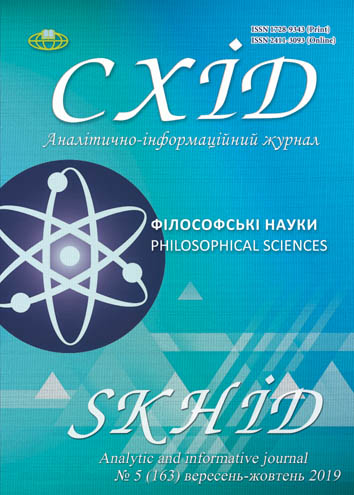Melos of the Undivided Church. Notes on the Interchurch Researches of Early Music
DOI:
https://doi.org/10.21847/1728-9343.2019.5(163).180794Keywords:
hymnography, Znamenny chant, Byzantine chant, Gregorian chant, semiotics of music, interchurch dialogueAbstract
New attention towards the ancient Church chant is especially on time in today’s Ukraine, where the renewed autocephalous Church is entering the global Christian community, looking back at its own historical and liturgical roots and trying to overcome the stereotypes about its tradition. The present article deals with the myths of different Christian musical traditions concerning themselves and their neighbors. Such myths implicitly express the yearning for the lost unity of the Church and condemn the Other for this loss. Hence they continue the dogmatic polemics in the domain of aesthetics. As we have demonstrated, such myths were constructed by the 19th-20th centuries historiographies of Church chant as an ideological impetus for the renewal of the relevant traditions. However “positive” mythologization of one’s own chanting tradition, firstly, retouched those dimensions of its image that were underestimated at that time, and secondly, often denigrated the neighbor traditions. So, the one-sidedness of such mythologization has provoked some modern cantors to engage into the joint reconstruction of authentic history of music together with their foreign colleagues. In this paper such collegial reconstructions - theoretical as well as practical - were for the first time assessed as an important dimension of interconfessional and interchurch dialogue. As we tried to show, they are not less necessary than the discussions in dogmatic field and their fruits are much more powerful than any “musical Esperanto” of popular Christian hymns.Downloads
References
Benvenist, E. (1974). Semiology of language. Obshchaya lingvistika. Мoscow, pp. 69-89 (In Russian).
Brazhnikov, M. (1960). Musical manuscripts from the archives of D. Razumovsky and V. Odoevsky. Sobraniya D.V. Razumovskogo i V.F. Odoevskogo. Moscow: 6-22. (In Russian).
Ciobanu, G. (1974 - 1992). Studii de etnomuzicologie şi bizantinologie. In 3 vols. Bucharest. (In Romanian).
Fotopoulos, K. (2006). Introduction into theory and practice of Byzantine Church chant. Glas Vizantii. Moscow. (In Russian)
Gerzman, E. (1989). The Development of Musical Culture. Kultura Vizantii. Vtoraya polovina VII-XII vv. Moscow: 557-571. (In Russian)
Herasymova-Persydska, N. (2012). The specific of the national variant of baroque in the Ukrainian music of 17th century. Muzyka. Vremia. Prostranstvo. Kyiv: Dukh I Litera. (In Ukrainian).
Kutuzov, B. (2008). Russian Znamenny Chant. Moscow, 300 p. (In Russian).
Lotman, Y. (1992). Canonic Art as an Information Paradox. Izbrannye statyi. Vol.1. Tallin, pp. 243-247. (In Russian).
Macarie Ieromonahul (1823). Irmologhion sau Catavasiery Musicesc. Vienna. (In Russian).
Manoussakis, J. P. (2007). God After Metaphysics. A Theological Aesthetic. Indiana University Press, 213 p. (In English)
Moisil, C. (2011). Romanian vs. Greek-Turkish-Persian-Arab: Imagining National Traits for Romanian Church Chant. Muzikologija, no 11: 119-132. Retrieved from https://www.academia.edu/10005622/Romanian_vs._Greek-Turkish-Persian-Arab_Imagining_National_Traits_for_Romanian_Church_Chant (In English)
Morozan, V. (ed.) (1991). One Thousand Years of Russian Church music: 988-1988. Washington. (In English).
Morozova, D. (2011). The Thought of God between the Letters and the Notes. Phenomenology of the Hymn in Antiphon with the Review of Approaches. Koinonia, 950: 313-342 Retrieved from http://www.intelros.ru/pdf/Konoyna/2/14.pdf. (In Russian).
Pann, A. (1845). Bazul theoretic şi practic al muzicii bisericeşti sau Gramatica melodicã. Bucharest. (In Romanian).
Pelikan, J. (1984). The Vindication of Tradition: The 1983 Jefferson Lecture in the Humanities. Yale. (In English).
Pérès, М. (2005). Lecture in Moscow State Conservatoire. 27 of May 2005 (In Russian).
Pérès, M. (2011). L'enseignement des musiques anciennes. Perpectives pour le XXIe siècle. Conférence prononcée à Genève, à la Haute Ecole de Musique le 14 janvier 2011 (In French).
Petrescu, I. D. (1872). Arta artelor sau Elemente de istoria musicei. Bucharest. (In Romanian).
Pitra, D. (1867). Hymnographie de l'Église grecque. Dissertation. Rome. (In French).
Popescu-Pasãrea, I. (1940). Evoluţia cântãrii psaltice în biserica românã. Cultura 29/3 (In Romanian).
Razumovsky, D. (1867). Church Chant in Russia. In 3 vols. Moscow. (In Russian).
Rousseau, Olivier. (1951). The Progress of the Liturgy. Vancouver. (In English).
Shishkov, Andrey (2017). Two Ecumenisms: Conservative Christian Alliances as a New Form of Ecumenical Cooperation. Gosudarstvo, religiia, tserkov’ v Rossii i za rubezhom, 35/1: 269-300 (In Russian).
Thibaut, P. J. (1907). Origine Byzantine de la Notation Neumatique de l'Église Latine. Paris. (In French)
Yasinovsky, Y. (2001). Music of 16-18th centuries. Istoriya ukrainskoy kultury. Кyiv. (In Russian).
Zelinsky, S. (2009). On the ‘Angelic Chant’ in Kyiv and Kyiv-Pecherst lavra. Retrieved from (https://risu.org.ua/ua/index/monitoring/kaleido_digest/38861/) (In Russian).
Downloads
Published
How to Cite
Issue
Section
License
Copyright (c) 2019 Daria Morozova

This work is licensed under a Creative Commons Attribution-NonCommercial-NoDerivatives 4.0 International License.
1. Authors bear responsibility for the accuracy of facts, quotations, numbers and names used.
2. Manuscripts are not sent back.
3. The publisher does not always agree with the authors' opinion.
4. The authors reserve the right to authorship of the work and pass the first publication right of this work to the journal under the terms of a Creative Commons Attribution-NonCommercial-NoDerivatives 4.0 International License. This license allows others to distribute (copy) the published work for non-commercial purposes, provided there is mandatory attribution to its authors and a link to the first publication in our journal.
5. The authors have the right to conclude separate supplement agreements that relate to non-exclusive work distribution in the form in which it has been published by the journal (for example, to upload the work to the online storage of the journal or publish it as part of a monograph), provided that the reference to the first publication of the work in this journal is included.

